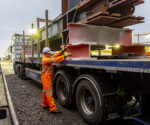Fire Door Opinion Piece
By Neil Ashdown, CertFDI, FSIDip. Fire Doors Complete Ltd
 Fire performance of composite construction fire door-sets is firmly in the spotlight. Fire resisting flat entrance doors are a critical part of the fire protection strategy at blocks of flats and due to the high level of security and thermal performance they offer together with low maintenance requirements, composite doors are a most popular choice for housing associations and authorities when replacing flat entrance doors.
Fire performance of composite construction fire door-sets is firmly in the spotlight. Fire resisting flat entrance doors are a critical part of the fire protection strategy at blocks of flats and due to the high level of security and thermal performance they offer together with low maintenance requirements, composite doors are a most popular choice for housing associations and authorities when replacing flat entrance doors.
However, after seeing the failure of the fire compartmentation system at Grenfell Tower we are well aware that a failure of flat entrance doors to provide sufficient fire and smoke separation performance can have catastrophic consequences. Therefore, in this article we will examine why the door’s fire and smoke performance is so important, what the government findings tell us so far and what can be done to improve fire performance of installed flat entrance doors.
Fire risk and the flat entrance door
Let’s imagine we live in a ten storey block of flats, with six flats on each floor and one central staircase. We can use the simple floor plan below to help us understand how we might be affected by a fire.
Statistically, if a fire should start its most likely to be accidental and most likely to happen inside one of the flats. Doors inside the flat would provide some fire resistance, if they are closed, but it is highly likely that the flat entrance door actually is the first line of defence. The person(s) inside the burning flat should leave, the flat entrance door should self-close behind them, they should call the fire service and also alert others at the block.
At the building there should be a fire strategy and the other occupants should know, in advance, whether they are required to either ‘stay-put’ inside their flat or to evacuate the building. Either way the performance of the flat entrance door is critical to life safety. First it should close automatically, if it fails to self-close then fire and smoke inside the burning flat will soon spread to the corridor leading to the staircase. It is vital that the corridors and stairs remain fire and smoke free and therefore tenable for those that need to escape as well as for fire fighters on their way to deal with the fire.
The flat entrance door should provide thirty minutes fire resistance from both sides. If there’s a fire inside the flat, the door should hold back fire and restrict the spread of smoke so that the corridor can be used in relative safety. On the other hand the flat entrance door should offer the same level of protection, in case of fire and smoke reaching the corridor, to protect occupants inside the flat until such time as the fire can be dealt with or the occupants are rescued.
The Ministry of Housing, Communities & Local Government
In January 2018 the Department for Communities and Local Government changed its name to the Ministry of Housing, Communities and Local Government and renewed its focus on housing. Before we look at fire door related announcements from MHCLG let’s look at some findings by Dr Barbara Lane in the wake of the Grenfell tower fire. You can read the full report at https://www.grenfelltowerinquiry.org.uk/evidence/dr-barbara-lanes-expert-report
Dr Lane’s report says that of the entrance doors to 120 flats at Grenfell Tower, on the night of the fire, 58 were unglazed Masterdor Suredors and 48 were glazed Masterdor Suredors. These doors were installed in 2011 as part of a replacement door programme. 14 doors were not replaced at that time. The report goes on to say the Masterdor Suredor doors “……..were composite form (filled with polymeric foam)………”. Dr Lane’s report says that she assessed all 106 doors as non-compliant with the current statutory guidance and that this non-compliance would have contributed to the failure to prevent the spread of fire and hot smoke from the flat to the lobby. Such failure would have materially affected the ability or willingness of occupants to escape through the lobby to the stairs.
In July MHCLG produced Advice Note 16 containing advice for building owners when replacing flat entrance doors and part of the advice was that Flat entrance fire doors should have test evidence demonstrating they meet the performance requirement in “Building Regulations guidance for fire resistance and smoke control from both sides”. Advice in the same document said that “Landlords or building owners should replace flat entrance door-sets if they suspect they do not meet the fire or smoke resistance performance in the Building Regulations guidance. Fire risk assessment processes should be used to determine how urgently such doors should be replaced”.
Prior to that media reports had informed us that five different fire doors had failed to meet the required thirty minutes fire performance when tested from both sides in recent MHCLG tests. No details were provided about the mechanics of the failures but it is my understanding that all doors that failed including the Masterdor Suredor were composite door-sets, some having timber-based door cores and some having other core types. Some doors were reported as glazed doors so its possible that the issue was around the glazing but my understanding is that this has not been confirmed. On 28th August MHCLG produced a further document to clarify their advice saying that with regard to fire performance tests from both sides that “……..this advice applies to composite doors only”. On 3rd September the publication Inside Housing reported that the National Housing Federation had warned that social housing landlords faced huge problems in finding replacements for faulty fire doors.
I have no information as to whether landlords are switching to timber fire door-sets as a result but as a Certificated Fire Door Inspector I have first-hand experience that housing associations are seeking assurances that newly supplied and installed fire doors to flat entrances are compliant. I also have first-hand experience that suppliers and installers have not always provided their clients with suitable documentation to support fire performance claims and importantly that installation work does not always meet the relevant standards.
Clearly there is work to be done in order to provide clients with the necessary assurances that installed composite flat entrance doors will meet fire and smoke performance requirements.
Fire performance tests
Fire performance testing of fire doors must be carried out in accordance with the requirements of BS 476 part 22 or BS EN 1634-1. Fire performance test reports and assessment reports can be provided to clients as evidence that doors have been successfully tested to the relevant standards. However, the buyer should check that the door supplied and installed is the same as the specimen that was successfully tested. Dr Lane’s report was clear that, in the case of Grenfell Tower, this was not the case because components different to those used in the test specimen had been used on the doors installed.
Membership of UKAS approved third party certification schemes provide a way of demonstrating that through periodic audits by a third party that fire doors supplied will meet the same standards as those originally tested. This should provide an additional level of assurance for building owners and landlords that the installed fire doors are compliant. However, such compliance is reliant on correct installation of the fire doors and of course that the initial tests were suitable and sufficient. If the fire door has fire performance test evidence from one side only and is a composite door-set then in following the current advice from MHCLG then it is clearly non-compliant, even if it carries third party certification under the scope of such a UKAS approved third party certification scheme.
In trying to confirm suitability of fire doors for my clients, I carefully examine fire performance documentation but I have yet to come across evidence that a fire door has been tested from both sides, only that the fire door has been tested with the door leaf opening in what the testing organisation states is the most onerous orientation. Currently as I write, details of the MHCLG fire door failures have not been released therefore we don’t know how significant is the both-sides testing advice. Furthermore, does the door core type make a difference in terms of timber-based core or a core construction using composite materials?
Clearly, in attempting to provide clients with the necessary assurances that installed composite flat entrance doors will meet fire and smoke performance requirements, there is work to be done here too.
The installed flat entrance door
As a direct result of the failure of fire compartmentation at Grenfell Tower, housing providers and other building owners and operators are seeking the services of fire door inspectors to confirm that fire doors supplied and installed meet the required standards and are therefore compliant. The landlord or building operator has a legal duty, in England & Wales, to comply with the Regulatory Reform (Fire Safety) Order 2005 and their Scottish and Northern Irish equivalents in those parts of the UK. Breaches of fire safety law are often severely punished so it is perfectly understandable that, in the case of flat entrance doors, the housing provider will insist on assurances that the installed fire door is compliant.
I have first-hand experience from thousands of fire door inspections that very often installation defects cause fire door non-compliance issues. These often vary from as something as basic as the door failing to self-close or incorrect fixing to the surrounding wall construction, to letter-plates that have not been tested or assessed for cold smoke restriction or the perimeter gaps between the door leaf and door frame being excessive.
This issue, of course, is not limited to composite door-sets but is common to all types of fire doors and often other fire separation products too, such as ablative batts and fire stopping. Even where third party certificated products have been used and installed by third party certificated installers, my inspections have revealed non-compliances. When Dame Judith Hackitt wrote, in the recent Hackitt Report, about the need for a change in culture around the supply and installation of fire safety provisions she was in my experience one hundred per cent correct.
Addressing the issues
The expert advisory panel appointed after the Grenfell Tower tragedy will, I am sure, continue to update their advice and the fire performance testing organisations and certification bodies will react accordingly. Then fire door manufacturers and suppliers will be able to provide the necessary assurances around fire and smoke separation performance for their clients.
Housing will of course continue to be a huge sector for the fire door industry and as a result of the Grenfell Tower tragedy housing providers will, I believe, carefully adhere to guidance around selection, installation, inspection and maintenance of fire doors. Guidance documents provide information about fire door installation, periodic inspections and maintenance requirements. Furthermore, opportunities for fire door installers and maintainers to receive specific training are available.
In the end it will be the competence and diligence of those of us working in the fire door industry, from manufacturers to installers, that delivers on the needs of our clients.
Neil Ashdown is the managing director of Fire Doors Complete Ltd and former manager of the Fire Door Inspection Scheme. His company provides fire door inspections, fire door consultancy work and fire door installation & maintenance training. www.firedoorscomplete.com











